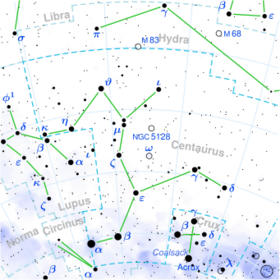Astronomy:Omicron1 Centauri
| Observation data Equinox J2000.0]] (ICRS) | |
|---|---|
| Constellation | Centaurus |
| Right ascension | 11h 31m 46.07s[1] |
| Declination | −59° 26′ 31.4″[1] |
| Apparent magnitude (V) | +5.13[2] |
| Characteristics | |
| Spectral type | G3 0-Ia[3][4] |
| B−V color index | +1.08[2] |
| Variable type | SRd[5] |
| Astrometry | |
| Radial velocity (Rv) | −20.00[6] km/s |
| Proper motion (μ) | RA: −4.491[1] mas/yr Dec.: +1.604[1] mas/yr |
| Parallax (π) | 0.3254 ± 0.0734[1] mas |
| Distance | approx. 10,000 ly (approx. 3,100 pc) |
| Absolute magnitude (MV) | −9.0[4] |
| Details | |
| Mass | 17[7] M☉ |
| Radius | 270[7] R☉ |
| Luminosity | 68,000[7] L☉ |
| Surface gravity (log g) | 0.19[8] cgs |
| Temperature | 4,873[9] K |
| Age | 10–12[7] Myr |
| Other designations | |
HR 4441, HD 100261, CD−58°4100, HIP 56243, SAO 239145, GC 15818, CCDM J11318-5927, AAVSO 1127-58 | |
| Database references | |
| SIMBAD | data |
Omicron1 Centauri (ο1 Cen, ο1 Centauri) is a star in the constellation Centaurus. It is approximately 10,000 light years from Earth.
ο1 Centauri is a yellow G-type supergiant or hypergiant with a mean apparent magnitude of +5.13. It is classified as a semiregular variable star and its brightness varies from magnitude +5.8 to +6.6 with a period of 200 days.[5] Other studies have reported only small brightness variations.[11][12] It is the MK spectral standard for class G3 O-Ia,[13] indicating a highly luminous mass-losing hypergiant star. It has also be classified as F8 Ia0[14] and F7 Ia/ab.[15] The size, luminosity, and distance are equally uncertain.
ο1 Cen forms a very close naked eye double star with ο2 Centauri, a hotter supergiant that may be physically associated. ο1 Cen also has an 11th magnitude companion only 13.5" distant,[16] Although it appears to be a foreground star unrelated to the other two.[17]
References
- ↑ 1.0 1.1 1.2 1.3 1.4 Vallenari, A. et al. (2022). "Gaia Data Release 3. Summary of the content and survey properties". Astronomy & Astrophysics. doi:10.1051/0004-6361/202243940 Gaia DR3 record for this source at VizieR.
- ↑ 2.0 2.1 Malyuto, V.; Schmidt-Kaler, T. (1997). "Quantitative spectral classification based on photoelectric spectrum scanner measurements of F-K stars". Astronomy and Astrophysics 325: 693. Bibcode: 1997A&A...325..693M.
- ↑ Keenan, P. C.; Pitts, R. E. (1980). "Revised MK spectral types for G, K, and M stars". Astrophysical Journal Supplement Series 42: 541. doi:10.1086/190662. Bibcode: 1980ApJS...42..541K.
- ↑ 4.0 4.1 Arellano Ferro, A.; Giridhar, Sunetra; Goswami, Aruna (1991). "A new discussion on the M(v) - W(O I 7774 A) relationship for F-G stars in the light of high-resolution data". Monthly Notices of the Royal Astronomical Society 250: 1. doi:10.1093/mnras/250.1.1. Bibcode: 1991MNRAS.250....1A.
- ↑ 5.0 5.1 Samus, N. N. et al. (2009). "VizieR Online Data Catalog: General Catalogue of Variable Stars (Samus+ 2007-2013)". VizieR On-line Data Catalog: B/GCVS. Originally Published in: 2009yCat....102025S 1. Bibcode: 2009yCat....102025S.
- ↑ Gontcharov, G. A. (2006). "Pulkovo Compilation of Radial Velocities for 35 495 Hipparcos stars in a common system". Astronomy Letters 32 (11): 759–771. doi:10.1134/S1063773706110065. Bibcode: 2006AstL...32..759G.
- ↑ 7.0 7.1 7.2 7.3 Kaler, James B., "Omicron 1,2 Centauri", Stars (University of Illinois), http://stars.astro.illinois.edu/sow/omicen.html, retrieved 2017-12-05
- ↑ Mallik, Sushma V. (1998). "The central depth of the Ca II triplet lines as a discriminant of chromospheric activity in late type stars". Bulletin of the Astronomical Society of India 26: 479. Bibcode: 1998BASI...26..479M.
- ↑ McDonald, I.; Zijlstra, A. A.; Boyer, M. L. (2012). "Fundamental parameters and infrared excesses of Hipparcos stars". Monthly Notices of the Royal Astronomical Society 427 (1): 343–357. doi:10.1111/j.1365-2966.2012.21873.x. Bibcode: 2012MNRAS.427..343M.
- ↑ O'Connell, D. J. K. (1961). "The semi-regular variable o1 Centauri". Ricerche Astronomiche 6 (13): 353–359. Bibcode: 1961RA......6..353O.
- ↑ Friedrich, D.; Schoffel, E. (1971). "New Bright Southern Variable Stars". Information Bulletin on Variable Stars 558: 1. Bibcode: 1971IBVS..558....1F.
- ↑ Sterken, C.; Manfroid, J.; Anton, K.; Barzewski, A.; Bibo, E.; Bruch, A.; Burger, M.; Duerbeck, H. W. et al. (1993). "Longterm Photometry of Variables at ESO - Part Two - the Second Data Catalogue 1986-1990". Astronomy and Astrophysics Supplement 102: 79. Bibcode: 1993A&AS..102...79S.
- ↑ Garcia, B. (1989). "A list of MK standard stars". Bulletin d'Information du Centre de Données Stellaires 36: 27. Bibcode: 1989BICDS..36...27G.
- ↑ Mantegazza, L. (1992). "Luminosities of yellow supergiants from near-infrared spectra - Calibration through Magellanic Cloud stars". Astronomy and Astrophysics 265: 527. Bibcode: 1992A&A...265..527M.
- ↑ Sowell, James R. (1990). "A survey of Balmer-line profiles and IRAS fluxes in forty yellow supergiants". Astronomical Journal 100: 834. doi:10.1086/115567. Bibcode: 1990AJ....100..834S.
- ↑ Mason, Brian D.; Wycoff, Gary L.; Hartkopf, William I.; Douglass, Geoffrey G.; Worley, Charles E. (2001). "The 2001 US Naval Observatory Double Star CD-ROM. I. The Washington Double Star Catalog". The Astronomical Journal 122 (6): 3466. doi:10.1086/323920. Bibcode: 2001AJ....122.3466M.
- ↑ Vallenari, A. et al. (2022). "Gaia Data Release 3. Summary of the content and survey properties". Astronomy & Astrophysics. doi:10.1051/0004-6361/202243940 Gaia DR3 record for this source at VizieR.
 |



